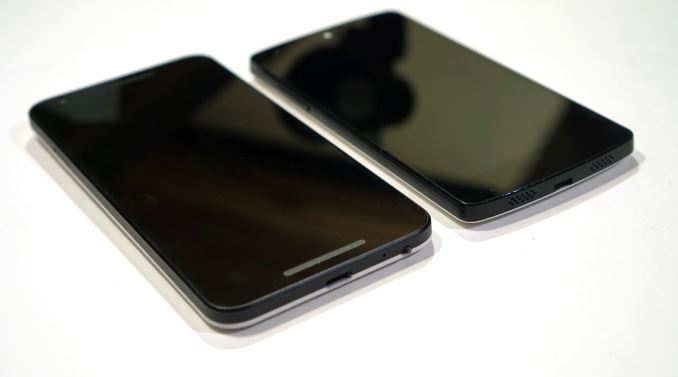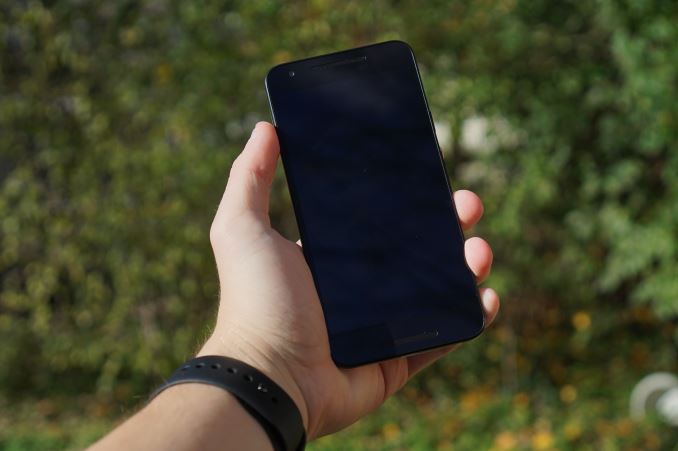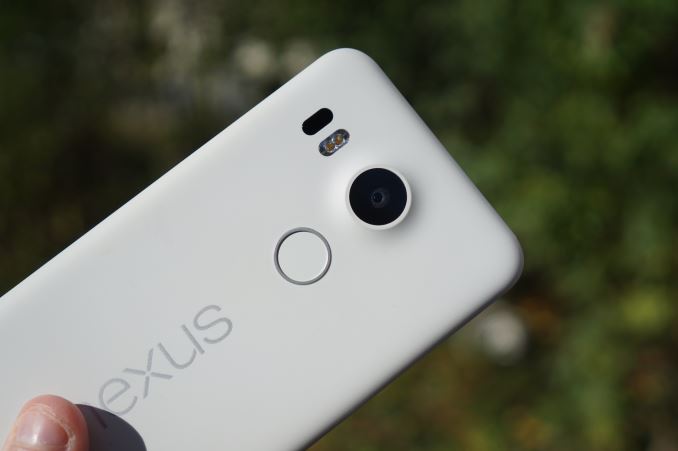The Google Nexus 5X Review
by Brandon Chester on November 9, 2015 8:00 AM EST- Posted in
- Smartphones
- LG
- Mobile
- Android 6.0
- Nexus 5X
Final Words
The Nexus 5X certainly isn't a perfect device. It's not meant to be a flagship phone and it's not priced like one; at $379 it's not the most expensive phone out there, but it's not exactly the cheapest one either. Still, I find myself really liking it despite its flaws. I definitely have a soft spot in my heart for the original Nexus 5, and I was quite disappointed when it didn't receive a true successor last year.
This year's 5X certainly is a true successor, but not every aspect delivers the improvements you would expect from a two year gap between releases. The performance isn't where you'd expect it to be, and Google's stance on disk encryption continues to reduce NAND performance. For all the things the 5X gets wrong though, it gets many other things really right. As always, it's nice to gather everything together in order to decide if a device is worth purchasing.
The design of the 5X is an interesting evolution of the LG Nexus industrial design. It's not as angular as the Nexus 5, but it's still very much a Nexus phone. The design delivered everything I expected from a successor to the Nexus 5, and I like it very much for what it is. The size of the phone is definitely pushing it for me, and I would opt for the size of the Nexus 5 if I had that option, but I also happen to struggle more than most people do with large devices. At $379 there's not much more you can realistically ask for than what the 5X's design and build quality offers.
The 5X's display is awesome, and there's really not much more that needs to be said. The Nexus 5 had a pretty good display for the time, but the 5X definitely takes the calibration and color reproduction to the next level. There's no more messed up low gamma curve, so the display doesn't have the washed out appearance that some people complained about with the Nexus 5's display. Brightness has also been boosted, and contrast is significantly higher too. I really couldn't ask for any more from an IPS LCD panel, and compared to what we got with last year's Nexus 6 the 5X is a breath of fresh air.
Performance is definitely an interesting case. To be frank, the 5X just isn't that much faster in many scenarios than the Nexus 5 was because of the heavy throttling. There's certainly improvement, but it's not what you would expect from two years of SoC progress. Snapdragon 808's heavy throttling means that for any task that taxes the CPU for over a couple of minutes you'd probably be better off with Snapdragon 801, and most certainly better off with 805. It's disappointing, but certainly forgivable when your device costs $379.
As for the GPU performance, Adreno 418 provides a healthy uplift in performance over Adreno 330, and beats Qualcomm's estimates which is great. What's interesting is that the Nexus 6 actually ends up pulling ahead despite being an older phone, which is just the result of how Qualcomm's GPUs were put onto their SoC roadmap. For $379 I think the GPU performance is solid, and there shouldn't be any problems running GPU intensive apps and games from Google Play.
NAND performance is definitely a big area of concern. I don't want to keep beating the issue to death, but Google needs to change their strategy here or they're going to fall very far behind in this regard and there will be no way to catch back up. Devices like the Galaxy S6, and even more so the iPhone 6s have shown how fast NAND speeds can reduce load times, reduce app install times, enable new camera abilities, and do many other things to improve the user experience. The gap between the storage performance of the LG G4 and the Nexus 5X is significant in size despite the two phones using the same NAND solution, and the end result is just completely unacceptable. On top of that, the use of the application processor to perform encryption has an enormous power penalty compared to a dedicated AES engine, which means there are potential battery life improvements just being left on the table.
That said, battery life on the Nexus 5X is quite good, although one should definitely note that the performance the Nexus 5X achieves in tests like BaseMark OS II's battery benchmark is behind that of competing devices that don't use Snapdragon 808 or 810. While it's a bit difficult to weigh these two things, it's essentially a question of whether or not it's worth it for a device to last for a long time when the performance over that period of time wouldn't have provided an enjoyable experience. In the end I think if you need the absolute best performance you're probably not going to opt for a non-flagship phone like the Nexus 5X anyway, and the battery life provided is more than adequate for the average user that will purchase it.
The last major thing to talk about is the camera. This is definitely a home run for Google. After a long period of n-1 cameras, or cameras that were up to par but lacking in processing, we finally get a Nexus device with an awesome camera. Both during the day and at night the quality was better than any of the other devices I used for comparisons, which included the previous two Nexus phones, the Galaxy S6 Edge, and the iPhone 6s. Low light was definitely the biggest victory, although I suspect that the Galaxy Note5 would come closer to the 5X than the S6 Edge does due to the improvements Samsung made to their image processing. In any case, the camera is as good as the flagship devices I've used, which is astonishing for a $379 device. The only drawbacks are the lack of OIS which contributes to shakier video than the previous Nexus phones put out, and the reliance on Google's HDR+ mode to achieve good results which puts a significant delay between shots and could introduce greater blurring in some circumstances. Even with those issues, I really love the Nexus 5X's camera, and it's become my everyday Android phone because of it.
Ultimately, the Nexus 5X is a true successor to the Nexus 5, and for $379 you really can't go wrong when buying one. You're getting a great display, a great camera, a great fingerprint scanner, good battery life, and a chassis that is most definitely plastic, but without any of the flex you see on cheaper devices. For me the camera alone sets the 5X apart from anything else in its price bracket, but pretty much every aspect of it is ahead of the competition at this price point unless you're willing to take a look at imports from Chinese manufacturers, which come with a whole host of other concerns regarding the warranty and network compatibility. The Nexus 5X definitely makes some tradeoffs in order to hit its price target, but if you're looking for a smartphone priced between $300 and $400 I highly recommend you take a look at the Nexus 5X.













197 Comments
View All Comments
Jojo99 - Monday, December 21, 2015 - link
Do you by chance have a 16GB model? And is everything lagging?I have a 32GB model and don't really notice any lagging at all. Don't have any lock-up problems either.
The camera is better than the Nexus 5 but still not great, especially in low light. Lot of noise. Highlights also often get blown out. Trying to understand why I am seeing EXIF info of ISO 60 in low light. Doesn't make sense.
Also like the LG Nexus 5, if you take a camera shot where the sun is in the frame, you'll get a small blue or green spot in the lower part of the shot.
The camera definitely not anywhere as good as my friend's iPhone 6 camera or my 8 year old Canon point and shoot..
Aloonatic - Tuesday, January 12, 2016 - link
I have the 32 GB model and it stalls, locks up, freezes, lags and apps crash often, with most apps I use, and when navigating system menus too.Performance wise, with general use, it's really no improvement over my 1st gen Moto G!
I've found that I've restarted this phone several times, 3 or 4 times a week at least. I wish I'd seen some of the comments here before buying one.
Aloonatic - Tuesday, January 12, 2016 - link
Why didn't I see your comment before I got one.I have no idea about the Nexus5 but my 5x has been a bit of a nightmare, and I replaced it as my Moto G was too slow and laggy, which I put down to it being 2 years old and lacking RAM, this is no better.
flyguy29 - Thursday, December 24, 2015 - link
I was under the belief that the Nexus devices were the flagship statement Google - collaborated smartphones... It's positioning as a "pure android" experience still does not address key touch points in overal consumer targets. But at least the mission statement is clear- a pure Android experience without any pretenses about superior screens, camera, etc- it's all about the fundamentals of a smart phone's functions and how a user engaged themAloonatic - Tuesday, January 12, 2016 - link
I got one of these after my 1st Gen Moto G started flagging and, frankly, I don't notice a great improvement in performance.-Sure, screen is bigger but the Moto Gs might have been small but it looked pretty good.
-The finger print senor is handy...
-However, it still stalls on unlocking all the time.
-Just trying to send a message can take 10s of seconds, and the keyboard often appears so you type, nothing happens, and then half a sentence appears in rapid fire.
-Switching between apps is still far too slow, and seems as slow as with my Moto G to me.
All in all, not a great deal of improvement over a cheap phone from a couple of years ago, which is pretty pathetic really, and seeing as this phone has more RAM and more horsepower under the hood you have to point the finger at Android OS itself, as others have mentioned.
blzd - Tuesday, January 19, 2016 - link
No performance issues on my 5x, runs as smooth as my N5 and gaming is not only faster, but the device runs considerably cooler while doing so.The camera and battery life are also big improvements over the N5.
If you have performance issues with your 5x look to your apps and services as the cause. Apps like Tasker and Snapchat have been known to be an issue. Also some users had issues restoring from a previous device and were able to resolve them by a factory reset without restoring.
Aloonatic - Sunday, February 7, 2016 - link
All I can say is that the N5 must have been terrible. Honestly, I have no axe to grind here(I've gone for a straight Nexus phone as I've tried every manufacturer out there and not been too impressed) , but this phone feels like a huge mistake to me.I am used to the normal smart phone cycle. 1st 6 months, great, everything is gravy. Then 6 to 18 months, it get gradually worse. THen the last 6 months are a grind where all you want to do is smash your phone into a million pieces as it's so slow and useless (even with factory resets etc, I'm not a muppet)
This phone feels like it's in the mid part of that cycle, so god knows what it'll be like at the endof my 24 month contract.
The battery is woeful, and I'm hardly a power user. I had to buy a car charger just to make it last the day.
I have only a handful of apps installed and they are all from major players, not a load kids making apps for fun and releasing them.
I have to power-cycle it multiple times each week.
It lags, it's slow, it's a mess.
Then the finger print scanner doesn't always work ,and the day dream mode fails all the time so it can't even work as a bed side clock when on charge any more.
It is no faster or smoother than my 2 year old Moto G.
Not worth the money.